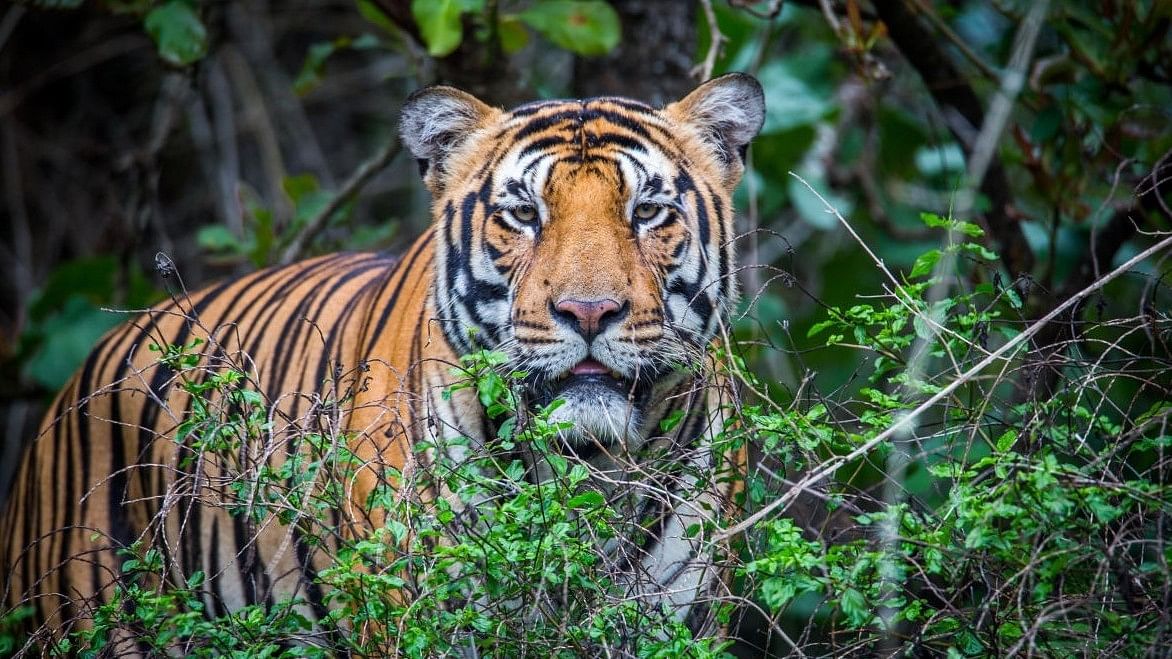
Representative image of a tiger
Credit: DH File photo
My journey into the deepest interiors of Dhikala zone in the sprawling Corbett Tiger Reserve one balmy February day this year simulated a journey in time, untouched by the magic of communication, mobile towers, and random technology spillovers. One was in close communion with nature in elemental state and within calling distance of the fast and the furious.
It is not that the tiger comes calling on safari visitors every day. That would, somehow, be unbecoming of royalty and an infringement of unstated jungle protocol. While elephants, sambar, barking and spotted deer besides monkeys, langurs, jackals and the twitterati fill in as proxies, the visitors’ ears strain to catch ‘alarm calls’ from the jungle collectivity proclaiming that the ‘king’ is nigh.
And it is not just the ears that participate in the tiger detection exercise. Getting into play is an entire sensory mechanism. Tell-tale pug marks advertise the tiger’s presence. The beast spares no effort in indicating its suzerainty over swathes of the jungle through territory-marking. When one encounters deeply etched marks on trees, it establishes that the tiger has put its claws to good use in making a power statement on its territorial rights. The deep-set claw marks publicise its formidable attributes as an adversary. The height of the marks on the tree trunk clawed by the tiger while rearing up on his hind legs convey “to all concerned” that he towers over his counterparts. This message is effectively supplemented through excretory devices, with liberal use of its poop and urine as additional territory-markers, to warn other predators against intrusion.
The three-hour safari through Dhikala zone, with the guide at the jeep’s wheel, was a tutorial on niceties of tiger behaviour. The jeep doubled as a classroom, as the guide shared his wisdom, while narrating experiences of encounters. We leaned on his instincts and knowledge of the forest to trail the tiger. Incidentally, monumental patience and luck to be at the right place at the right time hold the key to tiger-sighting.
A vast expanse of grass, tall enough to provide cover to three tigers perched one atop the other, automatically serves as willing ally for the tiger in any jungle. Corbett was no exception. Here too, the other denizens, especially deer, monkeys and birds, through their movements and alarm calls, did hint, at some stage, of the tiger’s lurking presence nearby. A solitary deer’s nostrils twitched, its face registering alert stillness, birds twittered incessantly,
with monkeys going into chattering frenzy. Acting on cue, we scanned the area in eager anticipation. No tiger emerged. It was about being near in terms of circumstantial evidence yet far in physical sighting.
Later, around midday, in a welcome anti-climax as our jeep was returning at the end of the safari, a tigress suddenly emerged from the thickets and crossed our path barely 50 metres ahead. It was followed by a cub, then another, and yet another. Luck was not just smiling. It had clearly broken into a broad grin.